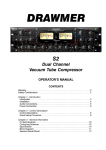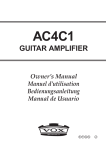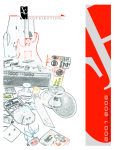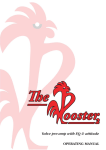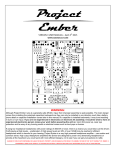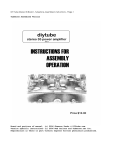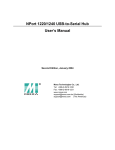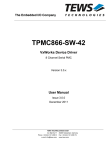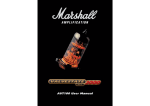Download Sarno Music Solutions Revelation Tube Preamp Owner`s manual
Transcript
Revelation Tube Preamp™ THE BOOK OF REVELATION OWNER’S MANUAL Rev. 2a –07/12/2014 RTP-2a St. Louis, Missouri TABLE OF CONTENTS Page 3! Introduction / About This Manual 4! Warnings 5! Front Panel 8! Rear Panel 9! Making Connections 10! Tech Notes 11! Tone Settings 12! Specifications / Tube Care & Maintenance! 13! Warranty 14! Service Information 2 INTRODUCTION Congratulations on your purchase of the Revelation Tube Preamp™. The RTP is an all-tube preamplifier designed primarily for the many unique needs of the steel guitarist, but will be equally at home with bass guitar, electric guitar, acoustic guitar or just about any amplified musical instrument. With the incorporation of the Variable Impedance (Vari-Z) input control, the sweepable midrange (Color) control, the Bright/Normal/Dark switch, the stereo, parallel effects return, film/foil capacitors, carefully selected metal film and carbon comp resistors, DC heater supply, and an alltube signal path, you’ll find a tonal flexibility and purity unlike any preamplifier you’ve heard before. The RTP is entirely hand built in the USA utilizing a hybrid construction method combining the best of both point-to-point hand wiring and high quality, thick-trace printed circuit board technology. Please keep the shipping box in a safe place for any potential future needs. ABOUT THIS MANUAL This manual was written to help you to use and enjoy this product to its fullest potential. Although the Revelation Tube Preamp is inherently simple to operate, it may contain features that may not be obvious from the front panel. Therefore, reading this manual is highly recommended to unlock the full potential of this product. 3 WARNINGS CAUTION: To reduce the risk of electrical shock, do not remove the cover. No user serviceable parts inside; refer servicing to qualified service personnel. WARNING: To reduce the risk of fire or electrical shock, do not expose this product to rain or moisture. The lightning flash with arrowhead symbol with an equilateral triangle is intended to alert the user to the presence of uninsulated “dangerous voltage” within the product’s enclosure that may be of sufficient magnitude to constitute a risk of electric shock to persons. The exclamation point within an equilateral triangle is intended to alert the user to the presence of important operating and maintenance (servicing) instructions in the literature accompanying the product. Before using your Revelation Tube Preamp, carefully read applicable items of operating instructions and safety suggestions. 1.!! Obey all warnings on the Revelation Tube Preamp and in The Book of Revelation ! ! Owner’s Manual. 2.!Do not perform service operations beyond those described in The Book of ! Revelation ! Owner’s Manual. In the following circumstances, repairs should be performed only by ! qualified service personnel: Ø Liquid is spilled into the unit Ø An object falls into the unit Ø The unit does not operate normally or changes in performance in a significant way Ø The unit is dropped or the enclosure is damaged 3.! Prolonged listening at high volume levels may cause irreparable hearing loss and/or ! damage. Be sure to practice “safe listening”. 4 FRONT PANEL A! Instrument input jack B! Variable Impedance (Vari-Z) and Pad switch – this control varies the loading on the pickup or input source. Although not a true tone control, the Vari-Z will help to tailor a pickup’s tonal character. It is most noticeable on magnetic pickups. Higher settings yield a crisper and brighter tone. Lower settings will mellow or darken the response. C! Volume pedal send and return jacks. This instrument level send/return loop is completely tube buffered from the input jack. It is where you would insert your volume pedal and/or any effects pedals. We recommend that your send and return cables be tightly twisted together to reduce the chance of unwanted hum. D ! Gain control. This is the preamp’s primary gain control. Lower settings will yield a cleaner and crisper tone. High settings will yield a warmer and thicker sound. This preamp is a clean machine and is not designed to give noticeable levels of distortion or overdrive as you’d find with many other guitar preamps. The high settings will only give very subtle shades of overdrive harmonics. For truly overdriven or distorted tones, it would best be accomplished by inserting an overdrive/distortion pedal in the volume pedal loop. 5 E! Bright/Normal/Dark switch. This multi-function switch tailors the very highest frequencies of the spectrum. You will notice that the “Bright“ setting is more dramatic with lower “Gain” settings, and is more subtle with high “Gain” settings. In fact, with the “Gain” on 10, the “Bright” does nothing. With this understanding, you can get a wide range of brightness from this simple switch. The middle position turns this control off and leaves the highest frequencies unaffected. The “Dark” setting will gently roll off the high frequencies reducing the crisp, higher frequencies from the tone. The “Dark” setting is not affected by the “Gain” level. This setting is especially handy when using the preamp for direct live or recording situations. When using a guitar speaker, the effect of the “Dark” position may appear subtle. It is more apparent when in a full range, direct situation. F! Treble control – this controls the amount of upper, treble band of frequencies. G! Midrange control – this controls the amount of midrange dip. Keep in mind that this type of passive equalizer circuit is a “dip-only” design as found in most all of the classic guitar amplifiers. With the midrange on 10, it is approaching flat, but will never actually boost the midrange. This has been the standard approach for guitar equalizer circuits as there is seldom any need for boosting this range. H! Color – this new control hasn’t been seen before in conjunction with this classic tone circuit design. It’s potentially the most confusing and most useful control on the RTP so a little explanation is necessary. This type of equalizer circuit in the RTP is “interactive”. The term interactive is used because the midrange dip frequency moves around in response to changes in the “Treble” setting. With high “Treble” settings, the midrange dip sweeps lower giving a more clear and defined midrange. With low “Treble” settings, the midrange dip sweeps higher giving a thicker, warmer midrange. For years people have found with the classic amp designs that a high treble setting may also bring along with it too much upper midrange bark. Now with the added “Color” control, you can add as much or as little treble as you’d like and then dial in the exact desired midrange coloration. So use the “Color” control in conjunction with the “Treble” control. As a general rule of thumb, higher “Treble” settings will want higher “Color” settings, and vice-versa. But there are no rules. Go nuts. A good starting point is to set “Color” at 5, make general tone adjustments, and then go from there. 6 I! Bass – this controls the level of the lowest or bass band of frequencies. J! Stereo Out/Aux In – this jack is a standard, unbalanced, stereo TRS (Tip, Ring, Sleeve) type jack. This jack has two functions. It can work as a stereo line-out for use as an additional line output or send. But it’s most practical use is as an Auxiliary input for connecting an amp modeler, CD player, keyboard/drum machine, iPod™, computer, or whatever to mix along with the instrument. The Aux input is “postEQ” so the tone controls of the Preamp will not affect it. K! FX – This knob is actually a stereo effects blend control. Since the effects loop in the RTP is parallel and not series, the FX knob acts as a mix control that blends in the returns from your effects unit along with your pure-tube dry signal. This also means that your FX unit needs to be set at 100% effect or else you may experience some unpleasant comb-filtering or phasing sounds. If you have both delay and reverb used simultaneously in your effects unit, be sure to configure the effects unit to route the two effects in parallel, not in series, and set the effect mix to 100% effect and no dry signal. L! Master – this controls the final master output level for both left and right channels. You’ll find with high “Gain” settings that you may need to back the Master down, and vice-versa. M! Pilot Lamp – this indicated that the unit is powered up, but does not indicate whether it is in “Run” or “Stand-By” mode. N! Stand-By – this switch places the RTP in stand-by mode. It should always be in the down position when powering up the unit. This is mainly to help prolong tube life. After the unit has been powered on, you should wait at least 15 seconds before putting the stand-by switch in the up or “Run” position. When powering down it doesn’t really matter where the “Stand-By” switch is set, but it’s a good habit to put it in the down position so the next time you power up, it’s in the safe, stand-by position. This switch is NOT a good mute for setbreak. Turn the master down instead. O! Power – this is the main power switch for the RTP. The pilot lamp will glow when this switch is in the up or on position. 7 REAR PANEL P! Left and Right main outputs - The upper 1/4” jacks are normal T/S (tip/sleeve) unbalanced outputs. The lower (optional) XLR jacks are true, transformer balanced outputs (pin 1 floating, pin 2 hot, pin 3 cold). Both the 1/4” and XLR outputs are active at all times. Both can be used simultaneously offering a total of 4 possible rear outputs, 2 balanced and 2 unbalanced. Keep in mind that the 1/4” outputs are the hot, highest level outputs. The XLR transformer outputs are padded down to a lower line level. This allows for easier use in live DI situations when a mix console or mic preamp is receiving the XLR balanced lines. Q! Left and Right FX returns – These are 1/4” unbalanced jacks. This is where you come from your effects unit’s outputs back into the RTP. Use the shortest cable runs possible. R! FX Send – this is a 1/4” unbalanced output. This is where you come out of the RTP and go to the input of your effects unit. Use the shortest cable runs possible. S! FX –Send Level – this rear panel control sets the strength of the signal sent to the input of the effects unit. This control needs to be set in relation to both the “Gain” control and also the needs of the effects unit. Typically an effects unit will have a visual indicator that tells how strong the input signal is. High “Gain” settings in the RTP will create higher FX send levels, thus the “FX Send Level” control needs to be set accordingly. Avoid clipping the input of your effects unit. Also avoid sending too weak of a signal to the effects unit. Generally, just leave this knob cranked on 10. g T! Tuner Out – Use this jack to connect to your electronic tuner. This output is buffered/isolated from the rest of the RTP’s circuit so that any digital noises and artifacts sometimes found with electronic tuners are prevented from entering the audio path of the preamp. This tuner ouput comes before the volume pedal loop so that you can silently tune by merely backing off the volume pedal. The tuner will still see a full signal from the instrument. 8 MAKING CONNECTIONS !! The RTP needs to be mounted and connected properly to insure the best performance and to avoid any unwanted hums or buzzes. It is best if the RTP is mounted in a rack with the effects unit right above it. If you are also using a rack mounted tuner, it should be mounted just above the effects unit. The cables that connect the RTP to and from the effects unit and tuner should be as short as possible. It’s best to make your own custom cables to make these connections just the right length. !! All devices connected to your setup should be powered from the same power source. This is for both safety and sonic reasons. !! The connections from the guitar and to the volume pedal are made with a !! 3-wire setup. The guitar goes straight to the input of the preamp. The volume pedal send and return cables should be the same length and should be neatly twisted together. It’s best to bundle all 3 of these wires, the input cable and the send and return cables, together. It’s recommended to braid or twist this trio together to minimize any hum. If the rack unit is to be placed directly next to your playing position, these cables can be made very short. 9 TECHNICAL NOTES Effects Loops: Parallel vs. Series A bit of explanation may be useful for understanding the nature of the parallel effects loop in the Revelation Tube Preamp™. This is regarding the rear panel effects send and returns, not the front panel volume pedal loop. Many preamps use a “series” type effects loop. There are advantages and disadvantages to both designs. We’ve chosen the “parallel” type loop for this preamp because of the tonal, sonic benefits. Series: With a series effects loop, the entire signal path leaves the preamp and passes through the effects unit subjecting the entire sound to all of the digital conversion, digital processing, and all of the electronic amplification stages within the effects unit. The wet/dry balance is determined by the controls on the effects unit. Then the entire signal path returns to the preamp to go on to the next stage. Parallel: With a parallel effects loop as we have here with the RTP, the dry, unaffected signal path remains completely within the preamp and never leaves the analog tube circuitry. The signal is split within the RTP and is sent out via the FX send jack to the effects unit’s input. The effects unit is set to 100% wet (effect only). Then this effect only signal is brought back into the RTP where the RTP’s FX knob blends or mixes the effect back in along with the pure tube signal still inside the preamp. The advantage of the parallel effects loop is that you preserve the sonic purity and analog-tube nature of the signal since you get to avoid subjecting it to any degradation that may come from the electronics of the effects unit. The dry, unaffected signal path in the RTP remains purely tube and analog from input to output. The disadvantage of the parallel effects loop is that it can sometimes make it difficult to effectively use effects such as chorus, flanger, phaser, rotary speaker or other modulated effects as they often require that the effects mix be set at levels less than 100% wet. The problem with sending dry signal thru the effects unit is that it may come back to the RTP with some slight latency. That means it may come back just a tiny bit delayed because of the digital processing in the effects unit. When you try to mix this slightly late dry signal back into the RTP, some ugly artifacts can occur such as comb filtering or phase problems. A parallel loop as in the RTP can also require that the effects unit itself be internally set up for parallel effects when using, for example, both reverb and delay at the same time. Many of today’s effects units allow for this option of running two effects such as reverb and delay side by side in parallel. Then with both effects set at 100% wet, the RTP can blend these back in with all of the benefits. This choice to design the RTP with a parallel FX loop was made primarily because of the obvious sonic benefits. Also, since the most commonly used effects are simply reverb and delay, the tradeoffs are negligible. 10 TONE SETTINGS The Revelation Tube Preamp™ has an extremely wide range of tonal possibilities. A good starting point is to set all tone controls and the Vari-Z at 5 except place the Treble at 3, and leave the bright/ dark switch in the middle (normal) position. You may want to leave the Color control on 5 as you further dial in the Treble, Mid, and Bass, and then use the Color knob to refine the midrange coloration. The Vari-Z control adds an entirely new variable to your tonal possibilities. Keep in mind that it is not an actual “tone” control as you’d find in the EQ section. It actually controls the tonal response of the pickup itself by loading it down in varying degrees. Low settings will darken the pickup’s response taming the crispness and pick attack down. High settings will open up the response giving lots of clarity and detail from the pickup. Each pickup will have a sweet spot or zone that sounds best. VERY IMPORTANT: Your Revelation Tube Preamp™ is new which means that the components will need time to fully break in and sound their best. New tubes and capacitors tend to sound a bit bright when new. After a few weeks of steady use, the RTP will take on an even smoother, warmer tonality. Once settled in, the RTP will maintain that quality for years to come. Also know that every time you power up the RTP from a cold start, it takes about 10 minutes for it to fully warm up and achieve it’s sonic potential. However, it will work just fine within 20 seconds of powering up. *Please Note: All other product and names are the property of their respective owners, and are used solely for the purpose of describing certain types of tones produced by the Revelation Tube Preamp™ which were developed independently by Sarno Music Solutions, LLC without the participation of these respective owners. Use of these product names does not imply any cooperation or endorsement. The with the Color control set on 5, the other EQ controls will be very reminiscent of an old Fender Twin*, Showman*, Vibrosonic*, or Bassman*. To get tones more like an older Evans* or Webb*, set the Color control at lower values and have the bright switch up/on. Color settings above 5 will give a darker tone with a thicker low midrange. Again, as a general rule, higher Treble settings will want higher Color settings, and vice versa. Also remember that the “bright” setting is more dramatic with lower “gain” settings, and at high “gain” settings, the “bright” setting becomes less effective. When using the RTP in a direct setup for recording or live performance, experiment with the Dark setting of the Bright/Dark switch. This will gently reduce the extreme highs to help the tone sound more natural as if it were being played thru a musical instrument speaker and not a full-range, multi-driver speaker like a studio monitor or PA speaker. 11 SPECIFICATIONS Tubes:! ! 3 – 12AX7 (ECC83, ECC803, 7025, 5751, or similar) Input Impedance:! Variable from 33kΩ to 1MΩ ! ! ! Weight:! 8 lbs. Dimensions:! 19” x 3.5” x 9” Fuse:! 1/2A slo-blo TUBE CARE & MAINTENANCE With proper startup procedures, the tube in the RTP should last for years with normal use. Remember to first turn on the power to the RTP with the Stand-By switch in the down position. After 15 seconds of warmup you can then move the Stand-By switch to the Run position. When the tubes begin to exhibit symptoms that suggest the need for replacement, the procedure is simple for any qualified person who understands the nature of a high voltage tube device. Only qualified personnel should attempt replacing the tubes. It must be done with the unit unplugged from the AC power source. Then the lid is carefully removed by the Phillips screws on the top of the lid as well as the one on the faceplate. The tubes are then easily accessed by hand. All Revelations made after October 10, 2008 are designed to operate with 12AX7’s or their counterparts (ECC83, ECC803, 7025, etc.) 12 WARRANTY 1. Sarno Music Solutions warrants the REVELATION TUBE PREAMP™ as free from any defects resulting from faulty materials or workmanship for a period of two (2) years from the date of sale; and six (6) months for the tube. This warranty is in lieu of all other warranties expressed or implied, and Sarno Music Solutions makes no further warranties expressed or implied including, but not so limited, any warranties of merchantability or fitness for any particular purpose. Warranty does not cover: damage caused by misuse, abuse, product modification, neglect, improper installation or operation, attempted repair by unauthorized personnel, rental or any shipping damage. 2. The exclusive remedy in the event of defects in workmanship or material shall be the repair or replacement of such components found to be defective after examination and inspection by Sarno Music Solutions, or replacement of the REVELATION TUBE PREAMP™ whichever Sarno Music Solutions deems appropriate. Sarno Music Solutions shall bear the cost of transport of defective merchandise under warranty conditions ONLY. All shipping, risk of transport, and cost of repair and/or replacement work of the REVELATION TUBE PREAMP™ made AFTER the above stated warranty period shall be the responsibility of the Buyer. 3. It is expressly agreed that the Buyer or User shall have no claim against Sarno Music Solutions with respect to either personal injury or damage to property or loss of profit resulting from any defect or for any consequential damages, such as, but not so limited, loss of business opportunities, property or personal injury losses, etc. or for any indemnity, implied or expressed, with respect to claims by third parties, And Buyer shall indemnify Sarno Music Solutions against any and all claims by third parties against Sarno Music Solutions resulting from the use of equipment and/or materials purchased hereunder or from the use of any products made from or by said equipment or materials. 4. These Terms and conditions take precedent over all other terms and conditions, warranty statements or policies. 5. All warranties apply only to Sarno Music Solutions products purchased and used in the USA. 13 SERVICE INFORMATION Service and repairs of Sarno Music Solutions, LLC products are to be performed only at Sarno Music Solutions, LLC unless otherwise authorized in advance. Unauthorized service, repair, or modification will void this warranty. Return Authorization is required prior to sending products for repair. All items MUST be shipped to Sarno Music Solutions, LLC prepaid, insured, and properly packaged – unless otherwise authorized in advance. Always include a letter giving complete details of the problem along with your name, phone number and/or e-mail address where Sarno Music Solutions, LLC can contact you if necessary. SARNO MUSIC SOLUTIONS, LLC 852 ATALANTA AVENUE ST. LOUIS, MO 63119 314-962-7220 OUT-OF-WARRANTY SERVICE 1 Contact Sarno Music Solutions, LLC to obtain return authorization. 2 All items MUST be shipped to the above address prepaid, insured, and properly packaged. Products arriving in a non-standard package, which appear damaged, may be refused. Shipments received “freight-collect” will be refused. 3 Product must be shipped to Sarno Music Solutions, LLC address with a letter stating return shipping address and description of problem. 4 Your unit will receive quality service and will be returned transportation prepaid. Out-of-warranty billing will be determined by nature of required repairs. 14














